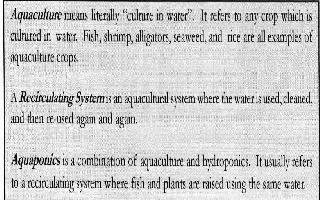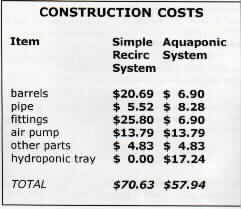The
Urban Aquaculture Manual
Table of Contents •
Chapter
1 • Chapter
2 • Chapter
3 • Chapter
4
The Urban Aquaculture Manual
by Jonathan Woods
Sponsored
by Heifer Project Internationalwith
assistance from the
Evangelical Lutheran Church of America
Table Of Contents
Chapter One: Urban Aquaculture
Chapter Two: Simple Recirculuation System
Chapter Three: An Aquaponic System
Chapter Four: Resources
URBAN AQUACULTURE
INTRODUCTION
Aquaculture is a type of animal-based agriculture that can be practiced in small spaces. It is suitable for city people who want to raise food animals but have limited space to do it. Unfortunately, there is little information about urban aquaculture. This manual was written to give city dwellers information about aquaculture in the city.
This manual provides some basic knowledge about aquaculture. It tells you how to build two different aquaculture systems, a simple recalculating system and an aquaponic system. It also tells you how to maintain these systems and what to do if something goes wrong. Finally, it list", some good places to find out more about aquaculture.

PROS AND CONS
Raising fish in the city is not for everyone. To get good growth, fish have to be fed daily, and something goes wrong with their tank it needs to be fixed promptly. Here are some of the advantages and disadvantages of using the systems in this manual.
Advantages
1. You can raise fish and plants in a small amount of space.
2. You don't need a large garden plot or backyard.
3. Fresh fish are a nutritious and healthy food.
4. Food fish are often cheaper to raise yourself than to buy.
Disadvantages
1. Tanks take up space and are very heavy.
2. Tanks have to be kept warm if you intend to use them over the winter.
3. Indoors, an aquaculture system can make a room very humid.
4. Some fish can be tricky to raise.
COSTS
There are two types of costs to think about when you decide to build a system, construction costs and maintenance costs. You only have to pay construction costs once - when you build the system. Maintenance costs include things like food, electricity, and repairs. These are paid for as long as you have the system. Estimates for construction costs (below) and maintenance costs (opposite page) for the two different systems are shown. By 'crop' I mean the time to raise and harvest a group of fish from fingerling to eating size.
Note that some of the materials that you need can be obtained for free or at a low price. These estimates are based on buying most material new at a large hardware store like Home Depot. Your costs might be higher or lower than these depending on where you show, and how much you can get for cheap or free.


BENEFITS
The reason that you are thinking about building a system is because of the benefits you will get. Fresh fish and vegetables, satisfaction from growing your own food, and even improved indoor air quality are all benefits that people have gotten from these systems. Below, I have show the dollar value of fish and vegetable yields that you can expect from a well- run system.

THE BOTTOM LINE
The value of the fish and plants that you grow is higher if you eat them yourself. This is because farmers can get paid a lot less for a crop than consumers pay for it in the grocery store. By eating what you grow, or sharing or trading it with neighbors, you will get higher economic benefits.
For each dollar that you spend in food, maintenance and utilities, you can expect to harvest $1.75 to $2.00 worth of fish. If you also are growing vegetables in the aquaponic system, then you will harvest $1.25 worth of vegetables as well. The total return per dollar is close to three dollars for the aquaponic system and two dollars for the simple recirculating system.
If you operate your system all year round, then you can recover the cost of construction in one to two years. Operating it only in the summer will lengthen this period to 3 or more years. So if you are planning to use one of these systems for more than 2 years, then it is worthwhile economically to build one.
If you feel entrepreneurial, you might consider building more or larger systems and selling your produce.
Running small businesses and operating large aquaculture tank systems are beyond the scope of this manual, but there are some references listed in the Resources Chapter that you could consult if you want to grow fish and vegetables for profit.
HOW TO START
The first thing you should do is read this manual through. This will help you get an overview of what is involved, what you will have to do, and what you can expect. Then go and get information or experience from other sources. is there somebody in your neighborhood who keeps tropical fish? They should be a good source of information.
Public libraries are also excellent places to find out more.
While you are learning about aquaculture from books and people, keep your eyes open for sources of cheap or free materials. You can save some money by spending time stockpiling things like barrels, pipe, and rocks.
ASK YOURSELF THREE QUESTIONS
Before you start building anything you should ask yourself a few basic questions. These will help you focus on what aquaculture is about and how you really feel about it.
1. Most importantly, do you like to eat fish? What about tilapia? It might be a good idea to buy a tilapla from a store and eat it, just to make sure that you like the taste. Remember that fresh fish that you raise yourself will taste better than frozen or dead ones from the store.
2. Are you (or somebody else who is going to be around to responsible feed and take care of the system? While you can leave these systems unattended for a few days, it is better if somebody is taking care of the fish on a daily basis. Things can go wrong quite quickly with fish, and aquaculturists who check their fish frequently tend to be successful.
3. Finally, why were you thinking about raising fish in the first place? If it was to get rich quick, you may want to reconsider. You won't become rich raising fish 'in barrels 'in your basement, unless they are rare tropical fish and you are an expert. If you want to raise fish so that you can grow your own food, near your own home, even in the city, then I think that's fantastic and encourage you to try it!
CONCLUSION
Raising fish in small aquaculture systems is a good way for city dwellers and people with limited space to raise animals for food. By considering the economic costs and benefits, and asking yourself what your motivations are, you can determine whether or not urban aquaculture Is a good idea for you.
